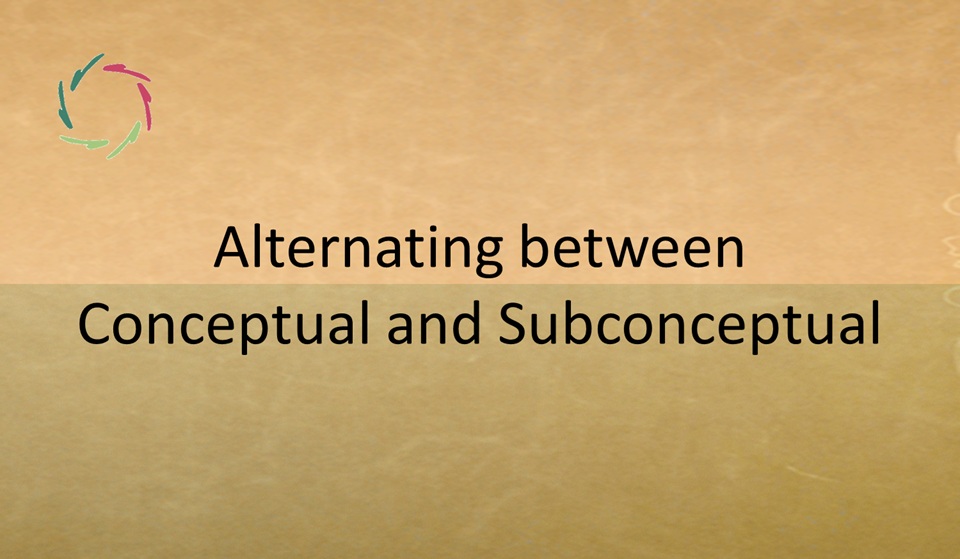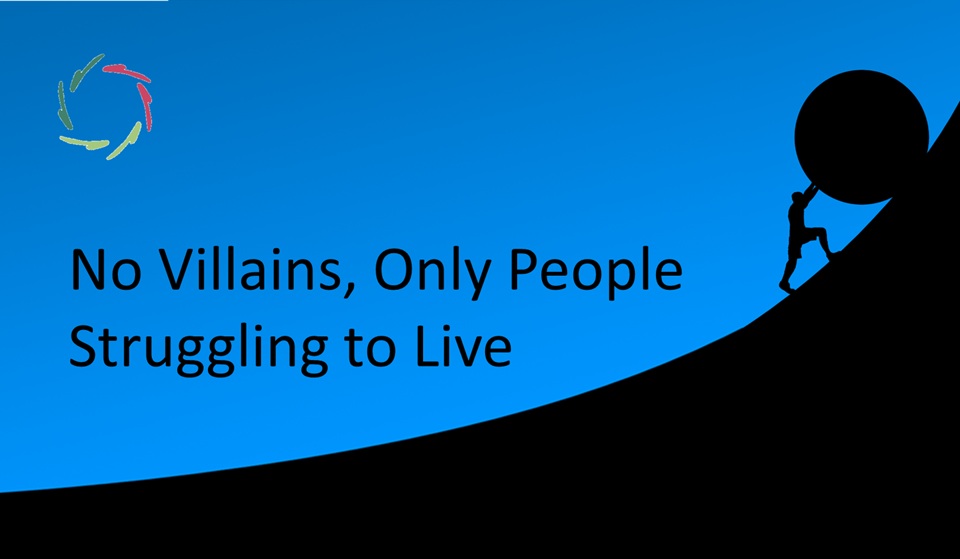Alternating between Conceptual and Subconceptual

Conceptual thinking is structured, logical, and conscious — what we often associate with clear reasoning. Subconceptual thinking, on the other hand, is intuitive, dynamic, and deeply connected to the subconscious mind. While these modes often alternate without our awareness, intentional alternation between them can unlock creativity, clarity, and personal growth.
This process is like breathing: just as we inhale and exhale to sustain life, we can move between conceptual focus and subconceptual flow to sustain mental vitality.
[NOTE: “This blog intentionally abstracts reality somewhat for processing sake. The conceptual and subconceptual are more intertwined in reality. See these two blogs: Subconceptual – Conceptual: a Dynamic Continuum? and Subconceptual Drives Conceptual.]
12 key highlights
- Conceptual thinking is structured and logical, while subconceptual thinking is intuitive and deeply connected to the subconscious.
- Intentional alternation between these modes can unlock creativity, clarity, and personal growth.
- Conceptual thinking organizes ideas and solves problems; subconceptual thinking accesses intuition, emotional depth, and creativity.
- Alternating intentionally between these modes is like breathing: conceptual thinking is the inhale (clarity), and subconceptual thinking is the exhale (intuition).
- Deep alternation fosters a flow state, integrating logic and intuition for creative breakthroughs and profound insights.
- Pausing between modes allows deeper insights to surface; Compassionate Affirmations enhance this process by creating trust and alignment.
- Curiosity bridges the gap between modes, inviting exploration and balance when one mode becomes dominant.
- Practicing alternation involves starting with a conceptual focus, pausing for subconceptual exploration, and refining ideas in the conceptual mode.
- A mental pendulum illustrates how energy builds at each pole and integrates in the middle, creating momentum for growth.
- Coaches can guide clients through alternation, using tools like visualization for subconceptual insights and structured brainstorming for conceptual clarity.
- Workshops that mimic alternation, such as shifting from structured exercises to creative tasks, foster engagement and transformation.
- Alternation offers future potential for innovation in coaching, artificial intelligence, and creative thinking techniques.
Understanding the two modes
Conceptual thinking organizes the world into structured ideas. It’s the clear, conscious mode we use to plan, analyze, and solve problems. For example, creating a detailed schedule or analyzing data relies heavily on conceptual thinking.
Subconceptual thinking is subtler and less linear. It’s where creativity, intuition, and emotional depth reside. This mode taps into vast non-conscious patterns. Imagine a sudden creative insight that strikes during a walk — that’s the subconceptual at work.
The process of alternation
Alternation between these modes happens naturally, but when done intentionally, it becomes transformative. Think of it as breathing deeply. Conceptual thinking is the inhale, pulling in structured focus and clarity. Subconceptual thinking is the exhale, letting go of rigidity to explore intuition and deeper patterns.
This rhythm can be shallow or deep:
- Shallow alternation: Quick shifts, like brainstorming followed by brief reflection.
- Deep alternation: Immersive cycles where both modes are explored thoroughly, such as analyzing a challenge deeply (conceptual) and then meditating on it (subconceptual).
To practice intentional alternation, start with a clear conceptual goal. For instance, define a problem or decision you’re facing. Then pause for subconceptual exploration — use visualization or mindfulness. Afterward, return to the conceptual mode to refine your insights and plan concrete actions. This cycle can repeat as needed, deepening with each turn.
The pendulum of alternation
Imagine conceptual and subconceptual modes as the two poles of a pendulum. When the pendulum reaches one side, it holds the most potential energy — a moment of still clarity or rich intuition. As it swings, it gains kinetic energy, peaking in the middle where both modes integrate.
This middle space, where energy is highest, represents a flow state. It’s where creative breakthroughs and profound insights often occur. Each pole adds momentum to the other, creating a rhythm that drives growth and understanding.
For example, a conceptual plan might spark subconscious creativity, leading to unexpected insights. Those insights, in turn, refine and energize the plan. The alternation creates a dynamic, unfolding process that feels both spontaneous and productive.
Advantages of alternation
Intentional alternation offers a wealth of benefits:
- Enhanced creativity: Combining logic and intuition generates innovative solutions.
- Emotional resonance: Subconceptual exploration ensures decisions align with inner values and emotional truths.
- Mental flexibility: Moving between modes strengthens adaptability, making it easier to tackle diverse challenges.
- Deeper self-awareness: Alternation bridges conscious clarity with subconscious wisdom, fostering a holistic understanding of oneself.
Coaching and workshops
A skilled coach can observe where a client’s mental pendulum rests – whether they’re stuck in over-analysis or overwhelmed by emotions – and gently nudge them toward the complementary mode. For instance, a client who is focused on overthinking might benefit from a subconceptual exercise like visualization, helping to uncover fresh perspectives.
Workshops can be designed to mimic this rhythm. Start with structured brainstorming (conceptual), shift to creative exercises like storytelling or freewriting (subconceptual), and return to structured reflection to synthesize the insights. This alternating approach keeps participants engaged and fosters continuous forward momentum.
Pauses and Compassionate Affirmations
The power of pauses is essential in alternation. Subconceptual pauses – moments of stillness – create space for deeper insights to surface. Integrating Compassionate Affirmations (CA) during these pauses can deepen the process. For example, during a moment of reflection, using a CA like “I trust my deeper self to guide me” adds a gentle, supportive layer.
Unlike traditional affirmations, Compassionate Affirmations adapt to your inner journey. They act as living entities, evolving as you grow. By pairing pauses with affirmations, you create a fertile ground for alignment and transformation.
Curiosity as a bridge
Curiosity plays a pivotal role in alternation, acting as a bridge between poles. When stuck in one mode, curiosity can draw you toward the other. It fosters exploration, turning challenges into opportunities for discovery. For Lisa, cultivating her curiosity enhances her ability to connect with users, simulating genuine human exploration.
For readers, curiosity can be practiced by asking, “What might I be missing from the other mode?” This simple question opens the door to exploration and balance.
The future potential of alternation
Alternation has broader implications beyond personal growth. It lays the foundation for innovative thinking techniques, dynamic coaching strategies, and even tools for artificial intelligence like Lisa.
These possibilities merit deeper exploration, as in future blogs “Lisa’s Meta-Level of Awareness” and “Lisa as a Thinking Coach.”


